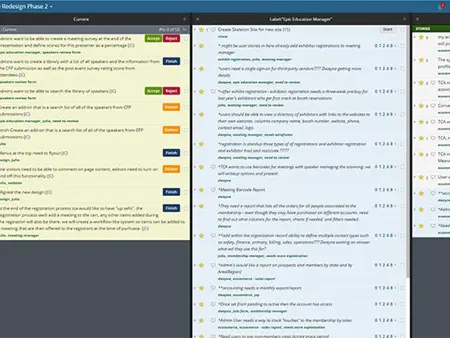
How to write User Stories for use in Agile Development
The era of shareholder capitalism is over. Market power has shifted to the customers, and consumers are now in charge. If businesses want to make money and survive, they can no longer shove products and services down the throats of buyers. In fact, they need to do more than simply satisfy their customers; they need to delight them.
Understanding the quality of the customer experience as opposed to counting up outputs, or ‘things delivered’, requires questions that get into the heads of consumers. Questions such as what is their current need, frustration, or experience looks at a product or service from a customer's view.
These insights can then be captured in the form of user stories. A user story is a simple narrative told from the perspective of someone who desires a new feature or experiences a problem. These short narratives give businesses access to what their customers think and feel, allowing companies to climb out of their self-centered profit hole, and into the minds of consumers. From this new perspective, businesses can begin to imagine what kind of product or service a customer wants, and most importantly, which kind will delight them.
Here Are 4 tips on how to employ User Stories in Agile Development
Starting Your Stories
Mike Cohn gives the basic form for the user story as such:
"As a (type of user), I want (some goal) so that (some reason)."
Notice the story is in first person. The effect this has on your team draws them into the mind of your clients and into their situation. By writing, “As a such-and-such, I want. . . ,” one instantly imagines what it is like to be that person.
Here are some concrete examples:
- As a parent, I want a better job, so that I can provide more for my family.
- As a business owner, I want employees that care about their work, so that we can offer better services to our customers.
- As a user of a blog, I want more features that improves my blog’s functionality, so that I can reach out and attract more readers.
Keep Your Stories Handwritten
User stories are often written down on index cards or sticky notes and showcased on walls or tables. Why this preference for handwritten notes over computers? Because information entered into a computer tends to become a fixed artifact, only accessible by one person at a time. However, the physical presence of handwritten notes sparks open conversations which enable software designers to explore new ways to delight their clients.
Remember, the story itself is less important than the discussion it facilitates. They serve as a starting point for new insights and inspirations that can make a product or service better.
Showcase Your Stories
The written story is not the final word, but the starting point for discussion. Displaying user stories tells everyone at a glance what has been completed, what is being worked on, and what remains to be done.The visibility and physical nature of handwritten notes channels the abstract requirements of software development into practical discussions towards what might delight and serve the customer.
Because we can touch them, hold the notes in our hands, the reality of a customer’s needs prompts real encouragement to solve the problem. Seeing the development and evolution of that discussion is like watching the skeleton of a problem flesh out into a new, exciting feature.
Measure Outcomes Not Outputs
Every individual within an organization must set the task of consistently delighting their customers. This requires the company’s overall work and progress to be measured in terms of client outcomes.
After any agile cycle, you and your team should ask yourselves if the work made the user story come true. Did it delight your customers? If yes, why so? If no, why not?
This focuses instead on measuring the quality of outcomes, rather than the number of outputs. While measurement has always been important, the issue is that companies measure the wrong things. The trouble with outputs is that they neglect these people-based results, or the outcomes with customers that really drive a business.
Shifting The Hierarchy Towards Community
However, any top-down communication or boss-subordinate relationship merely turns a user story into a vehicle for command, undermining the collaborative responsibility of every member within a company to delight their customers. Traditional management hierarchies only stifle user stories into a fixed abstract plan imposed upon a team.
Thus, individual managers must radically change their thoughts, attitudes, and behavior shifting hierarchical management to a more team-orientated approach. From there, the everyone within the company must place more emphasis on value on outcomes, rather than outputs.
The real transformation and benefits from user stories occurs when these customer narratives serve as the primary measure of progress, rather than tallying up the tasks completed. Organizations that strive to delight their customers must focus less on what they accomplish, and more on who they make happy, framing the latter around the former.
To learn more about the benefits of user stories and/or how to write and use them effectively when developing your web application, contact us today.